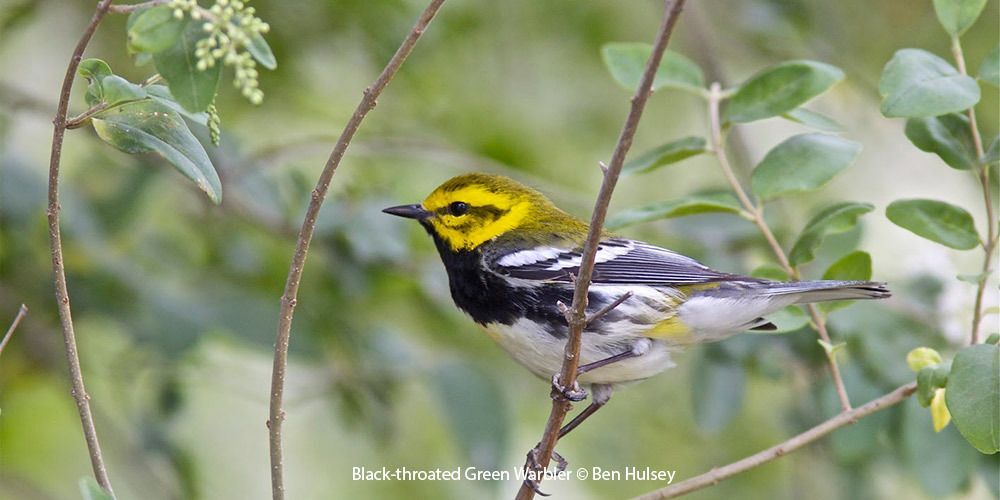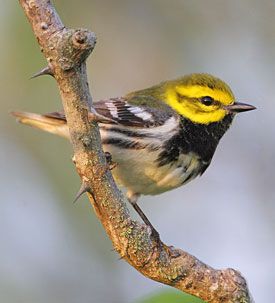
© Greg Lavaty
Black-throated Green Warbler
Setophaga virens
Family: (Parulidae) New World Warblers
Preferred Habitat: Woodlands.
Seasonal Occurrence: Common in spring; less common in fall.
Profile by Daniel Elting: The Black-throated Green Warbler is a small songbird that belongs to the large and diverse family of wood-warblers. They have a solid black bib, and a bright yellow face with a very dull green stripe through their eye and on their crown. The combination of these features makes them fairly distinct from other similar species and easy to identify in the field. The most similar species visually is the extremely rare Golden-cheeked Warbler which has a distinct black stripe through its eye and on its crown.
Black-throated Green Warblers are foliage gleaners, meaning they hop and fly around in trees and shrubs and pick off small insects from the branches. You will most often see these birds in heavily forested areas where it’s easy for them to find prey.
Black-throated Green Warblers are highly abundant breeders in the Northeast portion of the United States. They nest in trees typically about ten to twelve feet off the ground. Nests are a small open cup lined with twigs, feathers, spider silk, and moss. The Black-throated Green Warbler makes a distinct “zoo-zee, zoo-zoo-zee” song you will hear in the springtime. These birds sing constantly during the breeding season to attract mates, one individual was observed singing 466 times in one hour.
Black-throated Green Warblers are currently passing through Texas on their way to South America (during fall migration). Come to our sanctuaries at High Island to see them, we often have them in our woods this time of year. Although they are not singing the fall, if you hear a light “chip” up in the trees take a look up, it may be a Black-throated Green Warbler!
Profile by Rachel Myers: The Black-throated Green Warbler is one of the many species of warblers that migrate through the Upper Texas Coast and can be seen during spring migration. They can be seen in the area from March through May during spring migration and reappear in smaller numbers from August through November during fall migration. They are easy to distinguish from other spring migrant warblers and will join mixed flocks of warblers feeding on insects in trees. It is easy to see why they are closely related to Townsend’s, Hermit, and Golden-cheeked Warblers as they look similar, but all have certain characteristics that set them apart from each other as well as different ranges.
Male Black-throated Green Warblers, as their name suggests, have a bright yellow face, greenish ear patch and back, and a black throat. Females have the same yellow face and green ear patch and back but have a white throat. They also have heavy black streaks on their sides. Their song is often described as a buzzy zee zee zo zo zee or trees trees I love trees. Depending on where they are, Black-throated Green Warblers can be found in a variety of forested habitats. In the northwestern part of their range, they nest in conifer forests. In the southeast, they can be found in mixed hardwood forests in the southern Appalachians. In the Atlantic Coast, they are usually found in cypress swamps. In the winter, these warblers prefer tall forests.
During the breeding season, Black-throated Green Warblers almost exclusively eat insects, which they will glean from deciduous and coniferous trees. During migration, they will also eat berries and feed on buds from cecropia trees in their tropical wintering grounds. During breeding season, the female chooses the nest site, which is usually 3-10 feet off of the ground in a tree. The female also does most of the nest building, which takes 4 to 8 days to complete.
When on their breeding territory, males are aggressive and will attack and chase rivals. Pairs are monogamous but will only remain together during the season until shortly after the young leave the nest.
Like many warblers, Black-throated Green Warblers are long-distance migrants and winter in Middle America, northern South America, and the West Indies. They will then migrate north through the eastern United States to their breeding grounds across the Appalachians, the Northeastern United States, and Canada. During this time, when these birds are migrating across the Gulf of Mexico, they can be found in forested habitats and sanctuaries across the area such as Boy Scout Woods, Smith Oaks, Eubanks Woods, Gast Woods, Dos Vacas Muertas, and the Edith L. Moore Nature Sanctuary. Keep your eyes in the trees for these black throated, bright faced beauties!
-
Cornell Lab of Ornithology
-
Bird Guide
-
Bird Library
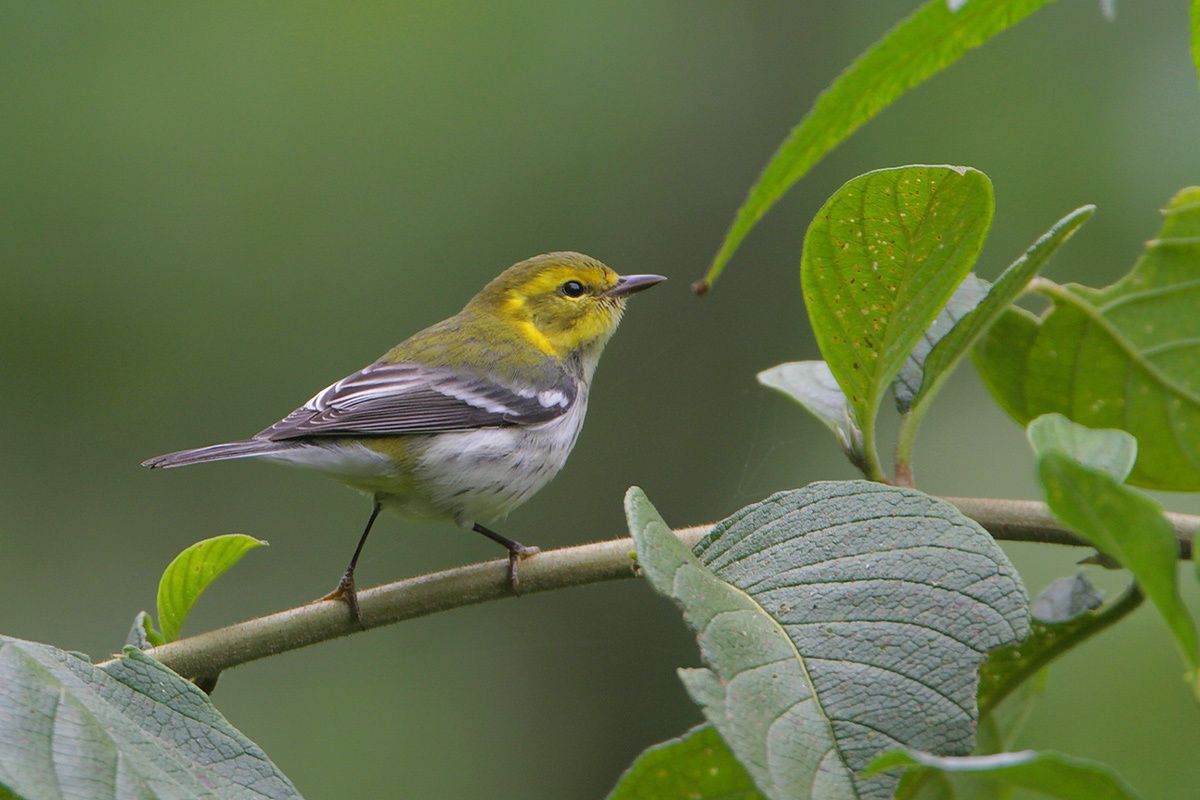
© Greg Lavaty, www.texastargetbirds.com
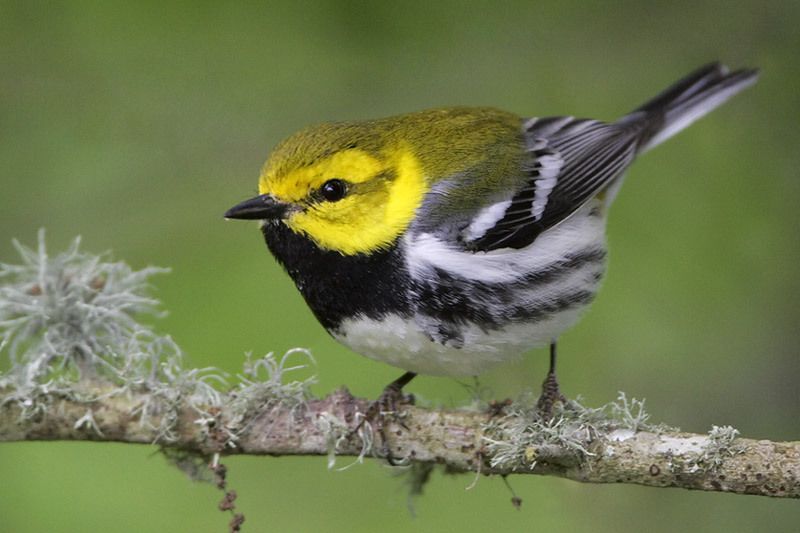
© Greg Lavaty, www.texastargetbirds.com
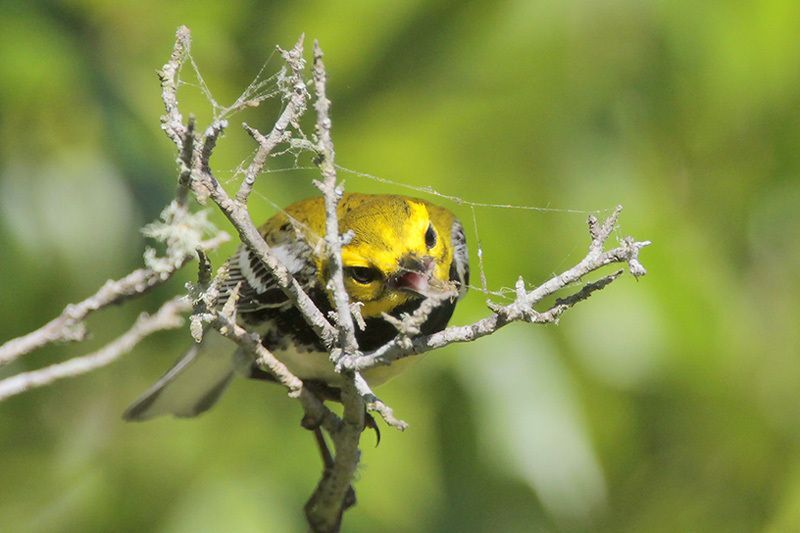
© Greg Lavaty, www.texastargetbirds.com

